The camouflage coatings market is estimated to be valued at USD 289.8 million in 2025 and is projected to reach USD 932.8 million by 2035, registering a compound annual growth rate (CAGR) of 12.4% over the forecast period. The market demonstrates a clear progression along the adoption lifecycle. During the early adoption phase from 2020 to 2024, the market grew from USD 161.5 million to USD 257.8 million as defense and specialized industrial applications began experimenting with advanced coatings. Investment in research and development, as well as pilot projects, drove gradual acceptance, with key players exploring new formulations and materials to enhance durability, stealth, and environmental resistance.
The scaling phase from 2025 to 2030 is characterized by rapid growth, with the market increasing from USD 289.8 million in 2025 to approximately USD 462.6 million by 2030. This period sees the wider adoption of technology across military and niche industrial applications, driven by technological maturation, cost optimization, and an increasing awareness of performance benefits. Manufacturers expand production capabilities, and distribution channels strengthen, enabling broader market penetration. From 2030 to 2035, the market enters a period of consolidation, reaching a value of USD 932.8 million. Growth stabilizes as large-scale adoption becomes the norm, competition intensifies, and strategic partnerships emerge to maintain market share. Innovation focuses on incremental enhancements, sustainability, and integration with multi-functional materials. Smaller or less agile players face consolidation or exit, while established companies dominate the landscape, reinforcing economies of scale and brand loyalty. The trajectory reflects a classic technology adoption curve from early experimentation to widespread, mature deployment.
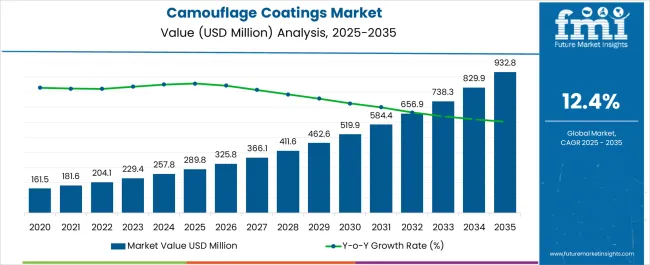
| Metric | Value |
|---|---|
| Camouflage Coatings Market Estimated Value in (2025 E) | USD 289.8 million |
| Camouflage Coatings Market Forecast Value in (2035 F) | USD 932.8 million |
| Forecast CAGR (2025 to 2035) | 12.4% |
The camouflage coatings market is gaining momentum as defense modernization programs, terrain adaptive technologies, and advanced material sciences continue to shape demand across military and tactical sectors. Increased focus on battlefield survivability, visual deception, and radar evasion is driving the integration of innovative coatings designed to blend with varied environments, including desert, forest, urban, and snow terrains.
Research in infrared reflective pigments, nanotechnology, and adaptive camouflage systems is further elevating the performance of these coatings in extreme operational conditions. Beyond defense, expansion into civilian security, hunting, and outdoor equipment is widening application potential.
Manufacturers are prioritizing durability, environmental compliance, and cost effectiveness while aligning with evolving geopolitical and defense procurement strategies. As global defense budgets continue to expand and operational requirements become increasingly sophisticated, the market is expected to maintain steady growth over the coming years.
The camouflage coatings market is segmented by type, application, end user, and geographic regions. By type, the camouflage coatings market is divided into Liquid coatings, Spray coatings, Powder coatings, and Others. In terms of application, the camouflage coatings market is classified into Textile coatings, Paints and finishes, and Others. Based on end user, the camouflage coatings market is segmented into Defense, Construction and infrastructure, Marine, Aerospace, and Others. Regionally, the camouflage coatings industry is classified into North America, Latin America, Western Europe, Eastern Europe, Balkan & Baltic Countries, Russia & Belarus, Central Asia, East Asia, South Asia & Pacific, and the Middle East & Africa.

The liquid coatings segment is expected to account for 47.30% of the total market revenue by 2025 within the type category, establishing it as the leading formulation. This dominance is supported by its ease of application on diverse substrates, adaptability to complex geometries, and effective adhesion in variable environmental conditions.
Liquid coatings offer flexibility in customizing camouflage patterns with high resolution finishes and are often preferred for their superior surface coverage and finish quality. They are widely used in both tactical gear and vehicle applications due to their performance consistency and cost efficiency.
The increasing use of advanced liquid formulations with weather resistance, UV stability, and quick drying properties has further elevated their demand. As field requirements evolve, liquid coatings remain central due to their reliability, versatility, and operational practicality.
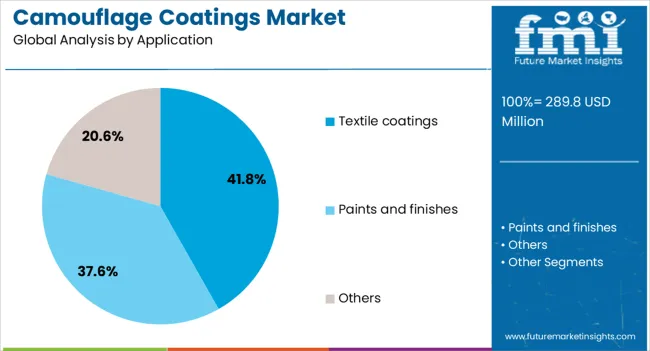
The textile coatings segment is projected to contribute 41.80% of overall market revenue by 2025 under the application category, positioning it as the most dominant segment. This is driven by the widespread demand for camouflaged uniforms, tactical gear, tents, and other fabric based military equipment.
Enhanced focus on lightweight, breathable, and environment specific apparel has reinforced the need for specialized textile coatings that maintain concealment effectiveness under thermal, visual, and infrared detection. Innovations in dyeing techniques and microencapsulation technologies have improved durability and pattern retention, even in harsh field conditions.
The combination of stealth performance and wearability has positioned textile coatings as a critical area of investment within the camouflage ecosystem, particularly as militaries standardize operations across multi-climate deployments.
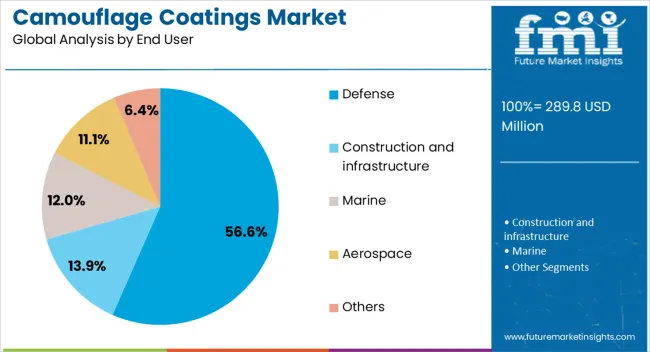
The defense segment is expected to command 56.60% of total market revenue by 2025 within the end use category, making it the leading consumer of camouflage coatings. This is driven by consistent procurement of combat vehicles, aircraft, naval assets, and personal protective equipment that require multispectral camouflage solutions.
Strategic defense modernization initiatives and the need for superior operational concealment in active conflict zones have reinforced adoption. Governments and defense contractors are increasingly emphasizing coatings that offer resistance to abrasion, chemical exposure, and extreme temperatures while maintaining environmental compliance.
Continued investment in next-generation camouflage capabilities has kept the defense sector at the forefront of demand. The critical nature of operational readiness and survivability ensures that the defense end use segment will continue to dominate the camouflage coatings market globally..
The camouflage coatings market is witnessing significant growth due to increasing defense modernization programs, demand for advanced stealth technology, and rising military expenditure globally. These coatings, designed to reduce radar, thermal, and visual signatures, are increasingly used on aircraft, naval vessels, armored vehicles, and military infrastructure. Technological innovations, including self-healing, adaptive, and multi-spectral camouflage coatings, are driving adoption. Market players focus on durable, eco-friendly formulations that withstand harsh environmental conditions. North America and Europe dominate due to high defense budgets and advanced research initiatives, while Asia-Pacific presents growth opportunities as militaries upgrade defense capabilities. Expansion strategies include collaborations with defense agencies, R&D in smart coatings, and integration with other protective solutions, enhancing battlefield survivability and operational effectiveness.
Technological advancements are a key growth driver for camouflage coatings. Research focuses on multi-spectral coatings that reduce visibility across infrared, ultraviolet, and radar spectrums. Self-healing and adaptive coatings improve operational life and provide dynamic response to environmental changes, enhancing stealth capabilities. Nanotechnology integration enhances adhesion, durability, and anti-corrosive properties, ensuring long-term effectiveness even in extreme weather conditions. Companies investing in R&D for lightweight and environmentally safe formulations gain an edge, especially for aircraft and armored vehicle applications. Additionally, combining camouflage coatings with thermal management technologies allows better heat signature suppression. As defense forces prioritize survivability and mission success, high-performance, next-generation coatings become a critical differentiator, enabling manufacturers to secure long-term contracts and expand into advanced defense projects.
The camouflage coatings market is highly competitive, with established defense suppliers and specialized regional manufacturers vying for contracts. Differentiation is based on technological innovation, coating performance, durability, and compliance with military standards. Raw material availability, particularly specialty pigments, nanomaterials, and chemical additives, affects production schedules and cost. Supply chain disruptions, including geopolitical issues or transportation delays, can impact timely delivery to defense projects. Companies investing in strategic sourcing, regional production facilities, and R&D partnerships enhance reliability and responsiveness. Additionally, long-term defense contracts favor vendors offering integrated solutions, technical support, and performance guarantees. Until supply chains and material standardization improve, market growth will remain closely linked to reliability, technological superiority, and established defense relationships.
Rising defense budgets and strategic modernization initiatives are driving camouflage coating adoption globally. Militaries aim to enhance survivability, reduce detection risk, and improve operational efficiency. Investments in next-generation aircraft, armored vehicles, and naval vessels require coatings that offer stealth across multiple spectrums. Regional conflicts and geopolitical tensions further accelerate demand for advanced protective solutions. Governments often favor suppliers with proven performance records and adherence to military standards. Collaboration between coating manufacturers and defense research institutions facilitates customized solutions for specific military platforms. While developed regions lead due to high procurement capacity, emerging economies are increasingly allocating funds toward defense modernization, creating new opportunities. Until military modernization continues, demand for camouflage coatings is expected to remain strong across global defense sectors.
Camouflage coatings face regulatory pressures related to environmental and health safety standards. Traditional coatings often contain volatile organic compounds (VOCs) or hazardous materials, leading to stricter emission limits and disposal regulations. Manufacturers must balance performance requirements with environmental compliance, especially for defense contracts in regions with stringent safety standards. Certifications and adherence to military specifications, including MIL-STD standards, are critical for market acceptance. Delays in regulatory approvals or failure to meet eco-friendly requirements can restrict market access. Companies investing in low-VOC, non-toxic, and environmentally sustainable formulations not only ensure compliance but also gain a competitive advantage in public and defense procurement. Until uniform global environmental standards emerge, manufacturers must navigate regional differences to maintain market presence.
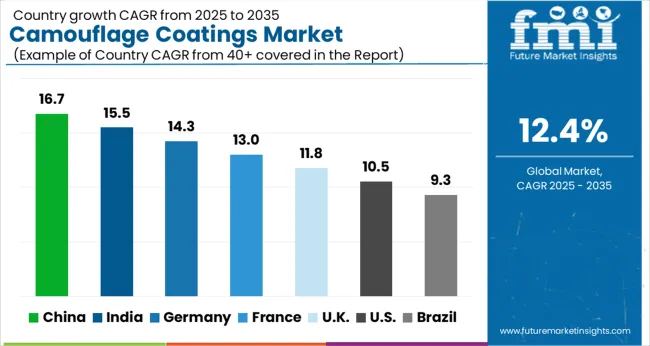
| Country | CAGR |
|---|---|
| China | 16.7% |
| India | 15.5% |
| Germany | 14.3% |
| France | 13.0% |
| UK | 11.8% |
| USA | 10.5% |
| Brazil | 9.3% |
The global Camouflage Coatings Market is projected to grow at a CAGR of 12.4% through 2035, supported by increasing demand across defense, industrial, and specialty coating applications. Among BRICS nations, China has been recorded with 16.7% growth, driven by large-scale production and deployment in military and industrial projects, while India has been observed at 15.5%, supported by rising utilization in defense and specialized coating applications. In the OECD region, Germany has been measured at 14.3%, where production and application in defense and industrial coatings have been steadily maintained. The United Kingdom has been noted at 11.8%, reflecting consistent deployment in military and specialty coating systems, while the USA has been recorded at 10.5%, with production and application across defense and industrial projects being steadily increased. This report includes insights on 40+ countries; the top five markets are shown here for reference.
The camouflage coatings market in China is growing at a CAGR of 16.7%, driven by increasing defense modernization programs, rising military expenditure, and adoption of advanced coating technologies. Camouflage coatings are widely used in military vehicles, aircraft, naval vessels, and defense infrastructure to reduce visibility and enhance operational security. Technological advancements, including durable, multi-environment coatings and thermal or radar-reducing solutions, are fueling market growth. Government initiatives to modernize the armed forces and strengthen national security further support demand. In addition, rising investments in research and development for innovative coating materials and environmentally friendly solutions contribute to market expansion. China’s focus on enhancing defense capabilities and strategic infrastructure ensures continued adoption of camouflage coatings across various military applications.
India’s camouflage coatings market is expanding at a CAGR of 15.5%, fueled by increasing defense expenditure and modernization of armed forces. Camouflage coatings are critical for military vehicles, aircraft, naval vessels, and infrastructure to improve operational security and concealment. Technological innovations such as long-lasting, weather-resistant, and multifunctional coatings are driving adoption. Government initiatives promoting indigenous defense production and strategic upgrades of military assets are major growth factors. Investments in research and development for environmentally friendly and high-performance coatings further enhance market potential. The Indian defense sector’s focus on modernizing ground, air, and naval systems ensures sustained demand for camouflage coatings across multiple applications.

The camouflage coatings market in Germany is growing at a CAGR of 14.3%, driven by modernization of military assets and advanced defense technology adoption. Camouflage coatings are used to reduce the visibility of vehicles, aircraft, and defense infrastructure in diverse operational environments. Advanced coating technologies, including thermal and radar signature reduction, durability, and eco-friendly formulations, support market expansion. Germany’s strategic focus on strengthening military readiness and defense capabilities drives consistent demand. Investments in research and development for high-performance, sustainable coatings enhance operational efficiency and environmental compliance. The integration of cutting-edge technologies in defense vehicles and infrastructure ensures steady growth of the camouflage coatings market in Germany.
The camouflage coatings market in the United Kingdom is expanding at a CAGR of 11.8%, driven by defense modernization, military upgrades, and advanced coating technologies. Camouflage coatings are used in military vehicles, aircraft, naval ships, and strategic installations to enhance operational security. Technological improvements, including multifunctional coatings that reduce visibility across thermal and radar spectrums, drive market adoption. Government defense programs focused on upgrading equipment, infrastructure, and R&D in coating technologies support growth. Rising emphasis on eco-friendly and high-durability coatings ensures compliance with environmental regulations while maintaining performance. The UK’s focus on modernizing armed forces and enhancing operational readiness ensures continued demand for camouflage coatings.
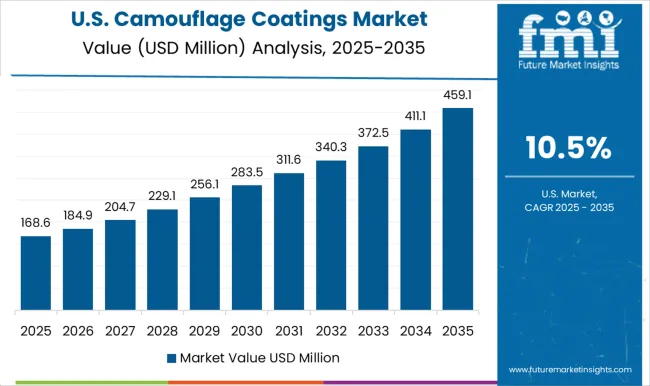
The camouflage coatings market in the United States is growing at a CAGR of 10.5%, driven by defense modernization, strategic military initiatives, and technological innovations. Camouflage coatings are widely deployed across military vehicles, aircraft, naval vessels, and defense installations to improve concealment and operational efficiency. Advanced solutions, including thermal, radar, and multi-environment coatings, enhance battlefield effectiveness. Government initiatives promoting modernization, indigenous defense technology development, and investments in research and development are major growth drivers. The USA military’s emphasis on sustainable, high-performance coatings ensures steady demand. Rising adoption of innovative materials and environmentally friendly formulations positions the market for continued growth in the North American defense sector.
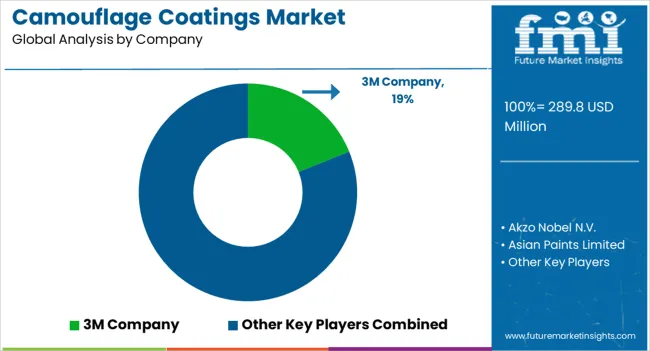
The camouflage coatings market is expanding as defense, aerospace, and industrial sectors demand advanced surface protection combined with concealment capabilities. Camouflage coatings are designed to reduce visibility, provide resistance to harsh environmental conditions, and enhance durability for military vehicles, equipment, and infrastructure. 3M Company is a key player offering innovative coatings with multi-environment concealment and durable performance. Akzo Nobel N.V. delivers specialized camouflage and protective coatings for defense applications, emphasizing corrosion resistance and long-term reliability. Asian Paints Limited provides tailored coating solutions for industrial and defense requirements, combining aesthetic and functional benefits. Axalta Coating Systems focuses on high-performance coatings for military vehicles and equipment, ensuring chemical and abrasion resistance. BASF SE develops advanced formulations that enhance surface durability while providing effective camouflage properties. Berger Paints India Limited offers protective coatings suitable for harsh operational environments in defense applications. Hempel A/S, Jotun Group, and Kansai Paint Co., Ltd. are recognized for their expertise in durable, weather-resistant coatings designed for military and industrial use. Nippon Paint Holdings Co., Ltd., PPG Industries, RPM International Inc., and Sherwin-Williams Company also contribute advanced solutions, combining camouflage functionality with environmental compliance and enhanced lifespan. These manufacturers collectively drive innovation in the camouflage coatings market, meeting evolving defense standards and operational demands while improving performance and protection of critical assets worldwide.
| Item | Value |
|---|---|
| Quantitative Units | USD 289.8 Million |
| Type | Liquid coatings, Spray coatings, Powder coatings, and Others |
| Application | Textile coatings, Paints and finishes, and Others |
| End User | Defense, Construction and infrastructure, Marine, Aerospace, and Others |
| Regions Covered | North America, Europe, Asia-Pacific, Latin America, Middle East & Africa |
| Country Covered | United States, Canada, Germany, France, United Kingdom, China, Japan, India, Brazil, South Africa |
| Key Companies Profiled | 3M Company, Akzo Nobel N.V., Asian Paints Limited, Axalta Coating Systems, BASF SE, Berger Paints India Limited, Hempel A/S, Jotun Group, Kansai Paint Co., Ltd., Nippon Paint Holdings Co., Ltd., PPG Industries, RPM International Inc., and Sherwin-Williams Company |
| Additional Attributes | Dollar sales vary by coating type, including spray coatings, liquid coatings, powder coatings, and specialty camouflage paints; by application, such as military vehicles, naval ships, aircraft, defense infrastructure, and personal equipment; by technology, spanning water-based, solvent-based, and advanced polymer/ceramic coatings; by region, led by North America, Europe, and Asia-Pacific. Growth is driven by increasing defense budgets, rising demand for advanced military technologies, adoption of stealth and radar-absorbing materials, advancements in coating durability and environmental resistance, and government initiatives for modernization of armed forces. |
The global camouflage coatings market is estimated to be valued at USD 289.8 million in 2025.
The market size for the camouflage coatings market is projected to reach USD 932.8 million by 2035.
The camouflage coatings market is expected to grow at a 12.4% CAGR between 2025 and 2035.
The key product types in camouflage coatings market are liquid coatings, spray coatings, powder coatings and others.
In terms of application, textile coatings segment to command 41.8% share in the camouflage coatings market in 2025.






Full Research Suite comprises of:
Market outlook & trends analysis
Interviews & case studies
Strategic recommendations
Vendor profiles & capabilities analysis
5-year forecasts
8 regions and 60+ country-level data splits
Market segment data splits
12 months of continuous data updates
DELIVERED AS:
PDF EXCEL ONLINE
Camouflage Netting Market Growth – Trends & Forecast 2024-2034
Adaptive Camouflage Materials Market Size and Share Forecast Outlook 2025 to 2035
Coatings and Application Technologies for Robotics Market Outlook – Trends & Innovations 2025-2035
UV Coatings Market Growth & Forecast 2025 to 2035
2K Coatings Market Growth – Trends & Forecast 2025 to 2035
Coil Coatings Market Size and Share Forecast Outlook 2025 to 2035
Pipe Coatings Market Size and Share Forecast Outlook 2025 to 2035
Wood Coatings Market Size, Growth, and Forecast for 2025 to 2035
Smart Coatings Market Size and Share Forecast Outlook 2025 to 2035
Green Coatings Market Analysis by Technology, Application, and Region Forecast through 2035
Marine Coatings Market Size and Share Forecast Outlook 2025 to 2035
Filter Coatings Market Size and Share Forecast Outlook 2025 to 2035
Rubber Coatings Market Growth - Trends & Forecast 2025 to 2035
Textile Coatings Market Size and Share Forecast Outlook 2025 to 2035
Stealth Coatings Market Size and Share Forecast Outlook 2025 to 2035
Medical Coatings Market Growth & Demand 2025 to 2035
Barrier Coatings for Packaging Market Trends - Growth & Forecast 2025 to 2035
Sputter Coating Market Growth – Trends & Forecast 2022 to 2032
UV Cured Coatings Market Size and Share Forecast Outlook 2025 to 2035
Food Can Coatings Market Size and Share Forecast Outlook 2025 to 2035

Thank you!
You will receive an email from our Business Development Manager. Please be sure to check your SPAM/JUNK folder too.
Chat With
MaRIA